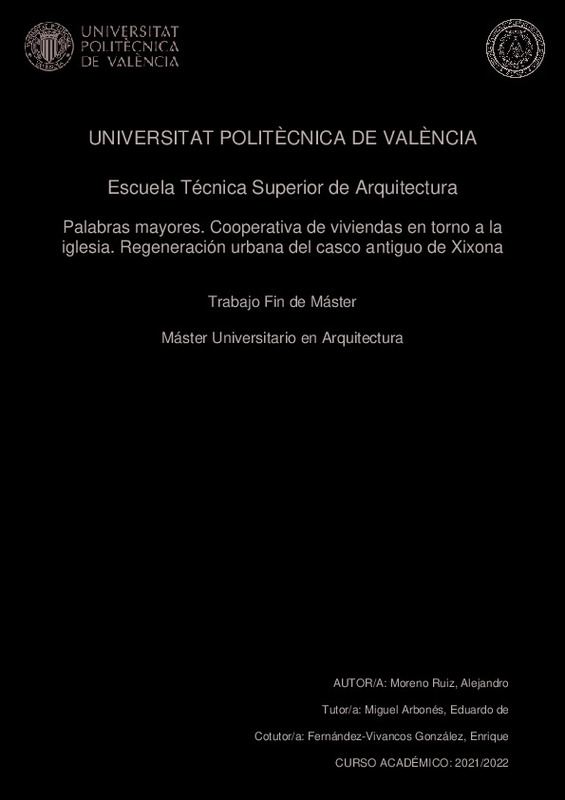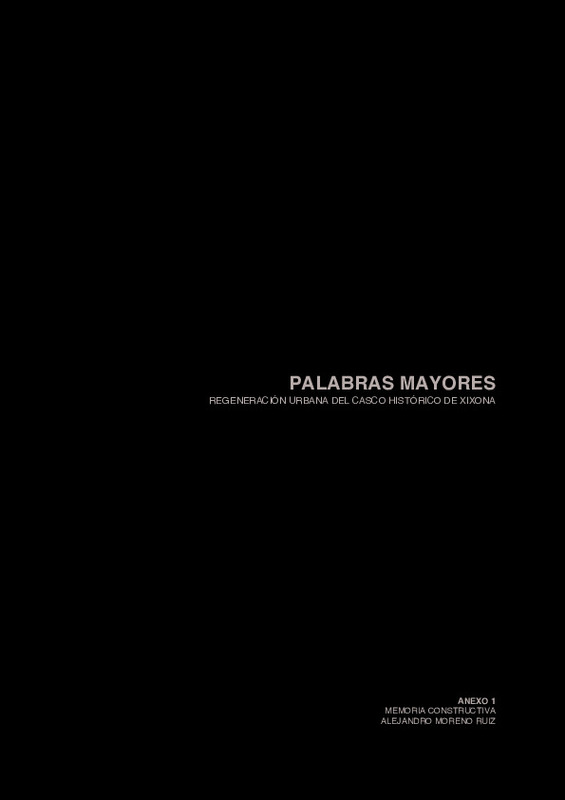|
Resumen:
|
[ES] El casco histórico de Xixona se encuentra sumido en un progresivo e implacable estado de abandono desde finales del siglo XX. No obstante, se trata de una población que se ha caracterizado por ser el motor económico ...[+]
[ES] El casco histórico de Xixona se encuentra sumido en un progresivo e implacable estado de abandono desde finales del siglo XX. No obstante, se trata de una población que se ha caracterizado por ser el motor económico e industrial de la comarca vinculando sus actividades principales al territorio y, en concreto, a la explotación de la almendra. A lo largo del siglo XX, el esplendor económico del que gozaba la ciudad eral tal que el núcleo urbano creció considerablemente hacía las partes bajas del valle.
Actualmente, la población ha logrado sobreponerse a fenómenos como la globalización e internacionalización del comercio consiguiendo abrirse un hueco en el panorama nacional e internacional gracias al cultivo y comercialización de productos locales entre los que encontramos principalmente el turrón. Sin embargo, la bonanza económica no se ha traducido en una mejora y actualización del centro histórico sino que la situación se ha agravado en estos últimos años.
Detrás del estado de ruina de la trama histórica de Xixona subyacen principalmente dos problemáticas que son catalizadores del fenómeno de abandono que sufre. Por un lado, la complicada accesibilidad que ofrece el trazado urbano y, por consiguiente, la dudosa calidad que ofrecen las viviendas. Por otro lado, la ausencia de oportunidades que traigan consigo estabilidad económica ya que el empleo vinculado al cultivo de la almendra es necesariamente estacionario.
Consecuentemente, y de acuerdo con los estudios socioeconómicos, los habitantes que permanecen en el centro de Xixona son, principalmente, familias que no han podido emigrar a la parte baja del pueblo bien por motivos económicos o bien porque son de avanzada edad. De hecho, la población del residente del casco histórico se encuentra un 11% más envejecida que la media nacional y, como resultado, existen un 13% más de personas dependientes.
Ante una población inminentemente envejecida, un trazado urbano impracticable, la ausencia de estabilidad laboral y, con ello, de población joven; se propone una solución aglutinadora capaz de dar respuesta a estas cuestiones mediante un proyecto que cuenta principalmente con dos líneas de acción. La primera de ellas, pretende dignificar las condiciones habitacionales de los residentes del casco histórico ahondando en cuestiones clave para nuestra sociedad como son la gerohabitación y el cuidado de nuestros mayores, entre otras. La segunda, tiene como objetivo principal la atracción de población joven ofreciendo una alternativa habitacional a la de las grandes urbes y atendiendo a cuestiones como la deslocalización laboral, la realidad del teletrabajo y la búsqueda de un nueva forma de hacer ciudad frente al ya caduco modelo de las grandes urbes.
La intervención se desarrolla en el límite del casco histórico, más concretamente en el encuentro entre el tejido urbano propio del centro y el del ensanche del siglo XX. Un lugar constituido por espacios de oportunidad donde el cruce de distintas situaciones puede convertirse en el embrión de nuevas tipologías. Un espacio gris en el que la hibridación entre tejidos confecciona un nuevo tejido intersticial capaz de establecer continuidades con lo existente sin renunciar a su propia identidad.
Así pues, la actuación hace de eje vertebrador entre importantes hitos en la trama urbana de Xixona como son el final de un importante eje comercial como es la Av. de la Constitució, la iglesia y su entorno más inmediato así como la conocida Plaça Nova. Se trata de un proyecto integrador que no solo pretende dotar a Xixona de nuevos modelos habitacionales sino que busca ser un elemento articulador del espacio público con una necesaria intervención a escala urbana que resolverá importantes problemas de accesibilidad.
[-]
[EN] The historic centre of Xixona has been in a progressive and relentless state of abandonment since the end of the 20th century. Nevertheless, it is a town that has been characterised for being the economic and industrial ...[+]
[EN] The historic centre of Xixona has been in a progressive and relentless state of abandonment since the end of the 20th century. Nevertheless, it is a town that has been characterised for being the economic and industrial engine of the region, linking its main activities to the territory and, specifically, to the exploitation of almonds. Throughout the 20th century, the economic splendour enjoyed by the town was such that the urban centre grew considerably towards the lower parts of the valley.
Nowadays, the town has managed to overcome phenomena such as the globalisation and internationalisation of trade and has managed to carve out a niche for itself on the national and international scene thanks to the cultivation and marketing of local products, among which we find mainly turron. However, the economic boom has not translated into an improvement and updating of the historic centre, but rather the situation has worsened in recent years.
Behind the state of ruin of the historic centre of Xixona lie two main problems that are catalysts for the phenomenon of abandonment it is suffering. On the one hand, the complicated accessibility offered by the urban layout and, consequently, the dubious quality of the housing. On the other hand, the lack of opportunities for economic stability, as employment linked to almond cultivation is necessarily seasonal.
Consequently, and according to socio-economic studies, the inhabitants who remain in the centre of Xixona are mainly families who have not been able to migrate to the lower part of the town either for economic reasons or due to their old age. In fact, the resident population of the old town is 11% older than the national average and, as a result, there are 13% more dependent people.
In light of this situation, a unifying solution capable of responding to these issues is proposed through a project that has two main lines of action. The first of these aims to dignify the housing conditions of the residents of the historic centre, delving into key issues for our society, such as housing and care for the elderly, among others. The second, has as its main objective the attraction of young people by offering a housing alternative to that of the big cities and addressing issues such as the relocation of work, the reality of teleworking and the search for a new way of making a city as opposed to the outdated model of the big cities.
The intervention takes place on the edge of the historic centre, more specifically at the meeting point between the urban grid of the centre and that of the twentieth-century urban expansion. A place made up of spaces of opportunity where the crossing of different situations can become the embryo of new typologies. A grey space in which the hybridisation of urban structures creates a new interstitial one capable of establishing continuities with the existing without renouncing its own identity.
Thus, the project acts as a backbone between important landmarks in the urban fabric of Xixona such as the end of an important commercial axis such as Av. de la Constitució, the church and its immediate surroundings as well as the well-known Plaça Nova. This is an integrating project that not only aims to provide Xixona with new housing models but also seeks to be an articulating element of the public space with a necessary intervention on an urban scale that will resolve important accessibility problems.
[-]
|








